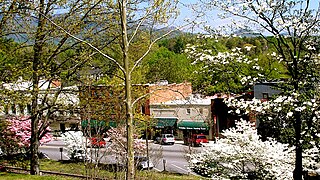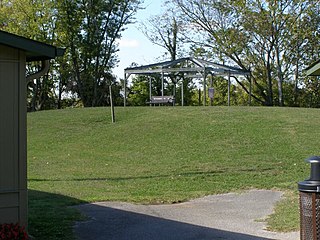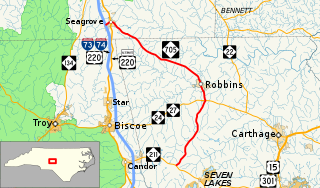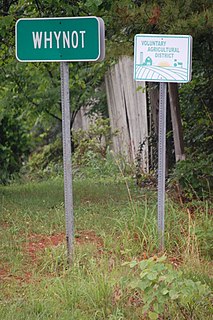
North Carolina is a state in the southeastern region of the United States. It borders South Carolina and Georgia to the south, Tennessee to the west, Virginia to the north, and the Atlantic Ocean to the east. North Carolina is the 28th-most extensive and the 9th-most populous of the U.S. states. The state is divided into 100 counties. The capital is Raleigh, which along with Durham and Chapel Hill is home to the largest research park in the United States. The most populous municipality is Charlotte, which is the second-largest banking center in the United States after New York City.

Chapel Hill is a town in Orange, Chatham, and Durham counties in the U.S. state of North Carolina. Its population was 57,233 in the 2010 census, making Chapel Hill the 15th-largest city in the state. Chapel Hill, Durham, and the state capital, Raleigh, make up the corners of the Research Triangle, with a total population of 1,998,808.

Winston-Salem is a city in and the county seat of Forsyth County, North Carolina, United States. With a 2019 estimated population of 251,907 it is the second largest municipality in the Piedmont Triad region, the fifth most populous city in North Carolina, and the eighty-ninth most populous city in the United States. With a metropolitan population of 676,673 it is the fourth largest metropolitan area in North Carolina and is expected to keep that fourth spot for many more years. Winston-Salem is home to the tallest office building in the region, 100 North Main Street, formerly the Wachovia Building and now known locally as the Wells Fargo Center.

Tryon is a town in Polk County, North Carolina, United States. As of the 2010 census, the city population was 1,646. Located in the escarpment of the Blue Ridge Mountains, the area is a center for outdoor pursuits, equestrian activity and fine arts.

Asheboro is a city in and the county seat of Randolph County, North Carolina, United States. The population was 25,012 at the 2010 census. It is the home of the state-owned North Carolina Zoo.

Seagrove is a town in Randolph County, North Carolina, United States. The population was 228 at the 2010 census. It was named after a railroad official when the area was connected by rail. The center of population of North Carolina is located a few miles east of Seagrove.

Elizabeth City is a city in Pasquotank County, North Carolina, in the United States. As of the 2014 census, it had a population of 18,047. Elizabeth City is the county seat and largest city of Pasquotank County. It is the cultural, economic and educational hub of the sixteen-county Historic Albemarle region of northeastern North Carolina.

Wickliffe Mounds is a prehistoric, Mississippian culture archaeological site located in Ballard County, Kentucky, just outside the town of Wickliffe, about 3 miles (4.8 km) from the confluence of the Ohio and Mississippi rivers. Archaeological investigations have linked the site with others along the Ohio River in Illinois and Kentucky as part of the Angel Phase of Mississippian culture. Wickliffe Mounds is controlled by the State Parks Service, which operates a museum at the site for interpretation of the ancient community. Listed on the National Register of Historic Places, it is also a Kentucky Archeological Landmark and State Historic Site.

North Carolina Highway 705 (NC 705) is a primary state highway in the U.S. state of North Carolina. The route is marked as the Pottery Highway or Pottery Road and as a North Carolina Scenic Byway due to the large number of potters in and surrounding Seagrove.
The Mint Museum is a cultural institution in Charlotte, North Carolina that comprises Mint Museum Randolph and Mint Museum Uptown. Together these two locations have hundreds of collections showcasing art and design from around the globe.

Town Creek Indian Mound is a prehistoric Native American archaeological site located near present-day Mount Gilead, Montgomery County, North Carolina, in the United States. The site, whose main features are a platform mound with a surrounding village and wooden defensive palisade, was built by the Pee Dee, a South Appalachian Mississippian culture people that developed in the region as early as 980 CE. They thrived in the Pee Dee River region of North and South Carolina during the Pre-Columbian era. The Town Creek site was an important ceremonial site occupied from about 1150—1400 CE. It was abandoned for unknown reasons. It is the only ceremonial mound and village center of that culture located within North Carolina.

Catawba Valley Pottery describes alkaline glazed stoneware made in the Catawba River Valley of Western North Carolina from the early 19th century, as well as certain contemporary pottery made in the region utilizing traditional methods and forms.

Erect, North Carolina is an unincorporated community in Randolph County, North Carolina, United States, and part of the Piedmont Triad metropolitan region. Erect is located on NC 42, seven miles east of the North Carolina Zoo in Asheboro, and two miles west of Coleridge. Erect was founded in the 18th century by German and English settlers, along with the nearby communities of Steeds, Sophia, Whynot, Hemp, and Lonely. Many of these settlers were known for their pottery-making skills. A post office called Erect was established in 1883, and remained in operation until it was discontinued in 1935. In 1889, Erect had a population of 39 inhabitants.

Whynot is an unincorporated community in Randolph County, North Carolina, United States, and is included in the Piedmont Triad metropolitan region. Whynot is located on NC 705, also known as the "North Carolina Pottery Highway", one mile (1.6 km) southeast of Seagrove and seven miles (11 km) west of Jugtown Pottery, a historic pottery listed on the National Register of Historic Places. The North Carolina Pottery Highway contains over 100 potteries and galleries in a 15-square-mile (39 km2) region surrounding Seagrove.
Mark Hewitt is an English studio potter living in the small town of Pittsboro, North Carolina outside of Chapel Hill, North Carolina, known for his functional pottery and especially for his large scale wood-fired, salt-glazed ceramic pots, known as "monster pots." His work is influenced by Asian pottery, African pottery, North Carolina pottery, and especially the English pottery of Bernard Leach. Hewitt was taught by Leach's first student, Michael Cardew.

Jugtown Pottery was founded in 1921 by Jacques and Juliana Busbee, artists from Raleigh, North Carolina, who in 1917 discovered an orange pie dish and traced it back to Moore County. There, they found a local tradition of utilitarian pottery in orange, earthenware, and salt glazes. The Busbees saw an opportunity to help save a dying craft, and in 1918 they set up the village store in Greenwich Village, New York, in order to sell the pottery. Potters they worked with over the years included JH Owen, Charlie Teague, and Ben Owen.
Owens Pottery may refer to:
Glenn and Lula Bolick are contemporary potters and musicians living in North Carolina. They are both recipients of the 2018 North Carolina Heritage Award for their work in traditional arts including pottery, music, and storytelling. Lula Bolick is a fifth generation potter, her great-grandfather having started what is now ("Original") Owens Pottery near Seagrove, North Carolina. The Bolicks started Bolick Family Pottery, which is located in Blowing Rock, North Carolina.













